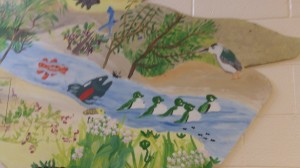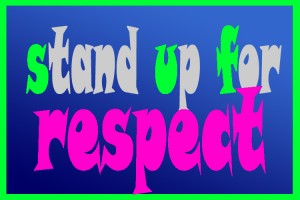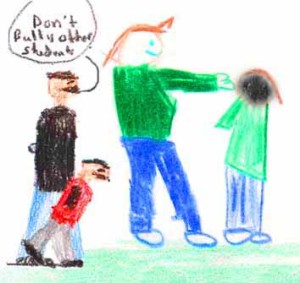
Ventura Park School students learn respect
Student role-plays and drama skits are a great way to help students learn social skills related to bullying. Here are some tips to get you started whether you are a parent, teacher, babysitter, caregiver, step parent, grandfather, daycare provider, grandmother, aunt, uncle or other interested adult.
1/ Next time a child reports an incident, whether it is bullying, teasing or other type of situation, take a minute to have them act out the scenario with one or two other people. The others could be children or adults or you could even pretend your pets are participants.
2/ As an alternative to #1 above, have the child act out the scenario with dolls, puppets or even paper cut-outs of characters.
3/ You be the narrator and set up the scene as described by the child. If you are not sure what comes next, let the child fill in the details.
4/ If the acted-out scenario starts to go in a mean direction or there is a nasty slant to the drama, just listen and then say: “now we’re going to do TAKE TWO which will be a bit different.” Explain to the child that it will start the same, but this time things get better when one character starts being a great role-model. Continue by giving the child a specific line to say which will change the direction of the drama.
5/ After the role-play has been acted out, let the child continue to focus on what has just happened by having them draw and colour a picture to go with the action.
6/ Use your iphone, android smart phone, flip cam or video camera to capture the drama and then plug it into the TV to show your child the action. Use this opportunity to discuss different directions the same situation could have taken. Give your child choices as to what they think would have been the best resolution to the situation. Take a still picture of the drama post a print-out on the fridge with a title such as “Great Role-Model”.
7/ Two or three days later, refer to the video role-play your child did and begin to discuss it again. Have your child re-visit the scenario by having them write a story about it. Tell them you’d like them to write a story to help a five-year who might be having some trouble getting along with others. This project can have meaning and value for a child who might otherwise not see themselves as a role-model or leader. Tell them that they are likely being watched everyday by children younger than themselves who learn from what they see.
 Yesterday, we visited Ventura Park Public School in Thornhill (greater Toronto region) and presented assemblies which used role-play as a teaching tool.
Yesterday, we visited Ventura Park Public School in Thornhill (greater Toronto region) and presented assemblies which used role-play as a teaching tool.
We were so impressed with Principal, Ms. Kim Wagner and Vice-Principal, Ms. Sonia Kadela, who emphasize respect on a daily basis at their school.
Here is a quick video of Ms. Kadela commenting on the Stand Up Assemblies featuring Benny DL as DJ of radio station ATFM.
(Learn more about Benny DL at www.standupnow.ca)

 After two months, between thirty and forty students were attending the meetings.
After two months, between thirty and forty students were attending the meetings. The mission of Richmond Rose P.S. is “Learning and Growing Together”. In 2005, students and staff created the Richmond Rose Touchstone to support everything we do. The following is the Richmond Rose Touchstone:
The mission of Richmond Rose P.S. is “Learning and Growing Together”. In 2005, students and staff created the Richmond Rose Touchstone to support everything we do. The following is the Richmond Rose Touchstone: In order to understand how racism, stereotyping, and bigotry are related to bullying, it is necessary to understand the following concepts.
In order to understand how racism, stereotyping, and bigotry are related to bullying, it is necessary to understand the following concepts.